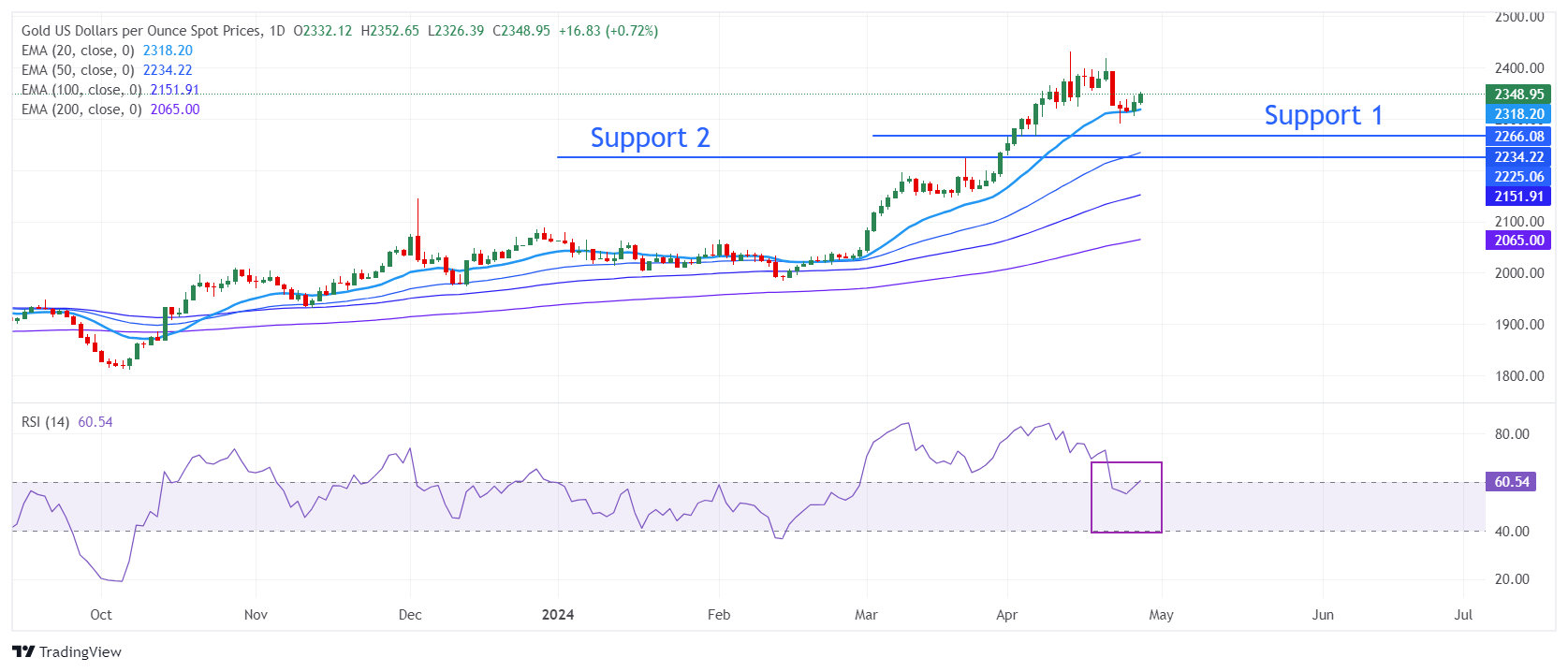Gold price moves higher with eyes on US core PCE inflation
- Gold price jumps to $2,350 as US Dollar drops after weak US Q1 GDP growth data.
- Investors look for US core PCE inflation data for more cues about the Fed’s rate cut timing.
- Market expectations for the Fed delaying rate cuts remain firm.
Gold price (XAU/USD) rises to $2,350 in Friday’s European session, showing strength ahead of the United States core Personal Consumption Expenditure Price Index (PCE) data for March, which will be published at 12:30 GMT.
US core PCE inflation is estimated to steady at 0.3% on month. The annual underlying inflation data is forecasted to have softened to 2.6% from 2.8% in February. Higher-than-expected figures would weaken Gold’s appeal as they would increase the opportunity cost of investing in it. On the contrary, signs of easing price pressures would provide some further support to the Gold price as they could increase expectations of early cuts from the Federal Reserve (Fed).
The US Dollar trades slightly up on Friday, but it fell on Thursday after weak US Q1 GDP growth raised doubts over the economy’s ability to maintain its strength in upcoming quarters. The US Dollar Index (DXY), which tracks the US Dollar’s value against six major currencies, hovers around 105.60.
Meanwhile, 10-year US bond yields are slightly down at 4.69% but are still close to a five-month high. Yields remain firm as investors see the Fed delaying rate cuts to later this year as progress in inflation declining to the 2% target seems to have stalled.
Daily digest market movers: Gold price likely set for bearish weekly close
- Gold price moves higher to the crucial resistance of $2,350. The precious metal got some relief from a weakening US Dollar, which suffered from a weaker-than-expected US economic growth rate for Q1. The US economy grew at an annualized pace of 1.6%, lower than the consensus of 2.5% and the former reading of 3.4%. This has raised concerns over the US economic outlook.
- Generally, a sharp decline in GDP growth could be the consequence of one or more factors such as weak household spending, limited monetary stimulus or less government spending. In theory, weaker-than-expected GDP growth should have boosted expectations for the Federal Reserve (Fed) to roll back its restrictive monetary policy stance, which it is maintaining since the strong stimulus due to the Covid-19 pandemic prompted inflationary pressures to historic levels.
- However, traders continued to pare back Fed rate cut bets due to stubbornly higher GDP Price Index data, which is a lagging inflation indicator. The inflation measure rose to 3.1% from the prior reading of 1.7%. The CME Fedwatch tool shows there is a 59% chance of a rate cut in September, down from the 69% recorded a week ago.
- Meanwhile, investors shift focus to the US core PCE Price Index data for March, which could provide more cues about when the Fed could start reducing interest rates. The underlying inflation data will also influence the Fed’s interest rate outlook ahead of the monetary policy meeting on May 1, in which the US central bank is widely anticipated to keep interest rates unchanged in the range of 5.25%-5.50%.
Technical Analysis: Gold price jumps to $2,350
Gold price rebounds after discovering buying interest near the 20-day Exponential Moving Average (EMA), which trades around $2,315. The near-to-long-term appeal remains strong as Exponential Moving Averages (EMAs) for short to longer terms are sloping higher.
On the downside, a three-week low near $2,265 and March 21 high at $2,223 will be major support zones for the Gold price.
The 14-period Relative Strength Index (RSI) falls below 60.00, suggesting that bullish momentum has come to an end at least for now. However, the long-term upside bias is intact as long as the RSI sustains above 40.00.
Gold FAQs
Gold has played a key role in human’s history as it has been widely used as a store of value and medium of exchange. Currently, apart from its shine and usage for jewelry, the precious metal is widely seen as a safe-haven asset, meaning that it is considered a good investment during turbulent times. Gold is also widely seen as a hedge against inflation and against depreciating currencies as it doesn’t rely on any specific issuer or government.
Central banks are the biggest Gold holders. In their aim to support their currencies in turbulent times, central banks tend to diversify their reserves and buy Gold to improve the perceived strength of the economy and the currency. High Gold reserves can be a source of trust for a country’s solvency. Central banks added 1,136 tonnes of Gold worth around $70 billion to their reserves in 2022, according to data from the World Gold Council. This is the highest yearly purchase since records began. Central banks from emerging economies such as China, India and Turkey are quickly increasing their Gold reserves.
Gold has an inverse correlation with the US Dollar and US Treasuries, which are both major reserve and safe-haven assets. When the Dollar depreciates, Gold tends to rise, enabling investors and central banks to diversify their assets in turbulent times. Gold is also inversely correlated with risk assets. A rally in the stock market tends to weaken Gold price, while sell-offs in riskier markets tend to favor the precious metal.
The price can move due to a wide range of factors. Geopolitical instability or fears of a deep recession can quickly make Gold price escalate due to its safe-haven status. As a yield-less asset, Gold tends to rise with lower interest rates, while higher cost of money usually weighs down on the yellow metal. Still, most moves depend on how the US Dollar (USD) behaves as the asset is priced in dollars (XAU/USD). A strong Dollar tends to keep the price of Gold controlled, whereas a weaker Dollar is likely to push Gold prices up.



